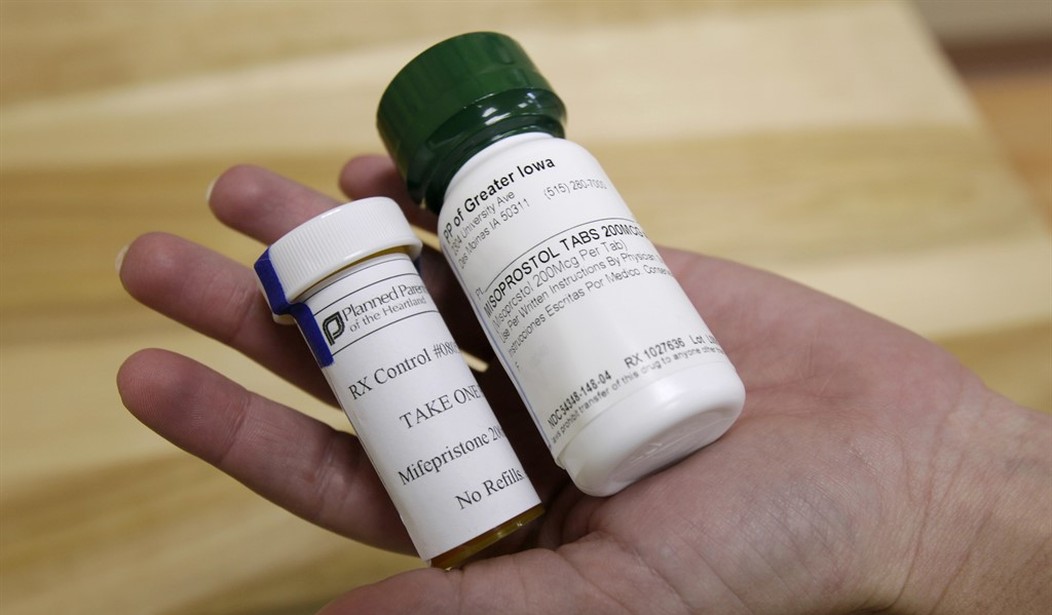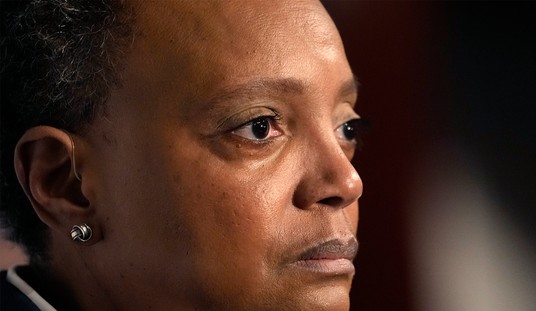For women looking to end a pregnancy, a chemical abortion can seem like an attractive option. Rather than travel to a clinic, run a gauntlet of protestors, and subject herself to a surgical procedure, all she needs to do is pop a couple of pills in the privacy of her own home and simply expel the unwanted progeny.
“For most people, the cramping and bleeding usually starts 1-4 hours after taking the misoprostol [the second pill]. It’s normal to see large blood clots (up to the size of a lemon) or clumps of tissue when this is happening. It’s kind of like having a really heavy, crampy period, and the process is very similar to an early miscarriage,” says Planned Parenthood. “The cramping and bleeding can last for several hours. Most people finish passing the pregnancy tissue in 4-5 hours, but it may take longer. The cramping and bleeding slows down after the pregnancy tissue comes out. You may have cramping on and off for 1 or 2 more days.”
And voilà! Problem solved. The whole unfortunate episode can simply be flushed away! Hence, the procedure is also sometimes tastefully referred to as a “toilet bowl” abortion.
So appealing is this simple at-home, “no fuss, no muss” process that currently, more than half of U.S. abortions are chemical. That number is expected to increase to at least 70% within a year. Unfortunately, women who are expecting a fast, easy solution to an unplanned pregnancy can instead find themselves even more traumatized than if they had gone the surgical route after all.
Related: Liberty Counsel Exposes Eugenics, Racism Inherent in Pro-abortion Movement
Support After Abortion (SAA) is a non-profit that “works with over 800+ agencies to individualize the care that a person impacted by abortion receives to find the hope and healing they deserve,” according to the group’s website. SAA was first conceived in 2016 in south Florida and launched in earnest the following year, connecting women and men with post-abortion healing programs. To further its effectiveness, SAA undertakes large-scale market research. The group just published the results of one such study, which it commissioned through ShapardResearch, that focused on whether there was a need for emotional assistance to women who conducted chemical abortions and whether they were able to obtain the help they needed:
The research found that 63% of women either sought after abortion help or said they could have benefited from talking to someone. Yet only 18% of the women were aware of organizations that provide care after reproductive loss. 34% of women said their outlook of themselves or the decision they made had changed negatively since their abortions, often years later. …
“It was 100 times more painful than [I was] told. It took over 12 hours to completely expel the tissue. It was so much more traumatic than a surgical abortion, which I had once before,” said one woman who participated in the survey.
But unexpectedly painful physical symptoms may be the least traumatic part of the experience.
“Support After Abortion research shows that having the responsibility for managing an abortion and disposing of the remains can be extremely distressing,” notes the report. “Administering their own abortions also can be an isolating and traumatic experience for women.”
A woman who undergoes a surgical abortion is generally not confronted with the grisly evidence of what she’s done. A toilet-bowl abortion involves the expulsion of a nascent human being along with the support system that had been growing in the mother’s body.
The SAA report mentions the British Pregnancy Advisory Service (BPAS), a nonprofit that partners with the UK’s National Health Service and runs a program called Pills by Post. On their website, BPAS advises how to dispose of “pregnancy remains”:
You will pass the pregnancy at home or another place of your choosing. You can decide how you wish to dispose of the pregnancy remains. They can be flushed down the lavatory or wrapped in tissue, placed in a small plastic bag and put in the dustbin.
BPAS also notes that “Bleeding and pain are often greatest when the pregnancy is being expelled. … You may see other tissue when you pass the pregnancy. This is larger and more recognisable at higher gestations, but in most cases the fetus cannot be seen without magnification. (emphasis mine)” God help the woman who glances into the bowl when it can.
The SAF study quoted several women who had been traumatized by what they had been led to believe was an inconsequential DIY process:
The abortion provider Women on Web shares testimonials from women who have experienced abortion, a number of whom suffer prolonged emotional pain. Some feel traumatized, terminating their pregnancies in the same bathrooms where they get ready for work or school.
A college student wrote her shame was so great that she hid her abortion from her mother, spending her Christmas money on the pills. She went through the painful process in isolation, with no one to help. “I actually heard the baby fetus go ‘dump’ in the toilet. And I just thought ‘what if that was me with my mom?’”
A young mother was traumatized by the sight of the developing fetus’s sac. “I felt a gush of blood and a ‘lump’ coming out. I rushed to the shower, and saw that I had expelled the fetus.… After being a mom of two, seeing that definitely shocked me. I felt terrible.”
All in all, the SAA findings were significant. “While some women expressed relief, many were traumatized by medication abortion, an experience they said was far more painful, physically and emotionally, than they had imagined. The study reinforces the need for forthright, transparent information on the impact of medication abortion and access to healing care.”
The research found that “34% of women reported an adverse change in themselves, including depression, anxiety, substance abuse and thoughts of suicide. ‘I regret it every day and cry about it often. It’s a very helplessness feeling,’ said one woman more than a year after her abortion. Another woman describes her emotional pain five years later. ‘I regret it still to this day and probably still will for the rest of my life,’ she said.”
It’s tragic anytime a woman feels like abortion is something she needs to do. With some states electing to restrict most abortions since Roe v. Wade was overturned, DIY abortion-by-mail will certainly become more prevalent. And the “It’s just a clump of cells” crowd is hard at work, selling desperate girls and women the seductive fairytale that they can simply take a pill and make it all go away, and everything will be just as it was before. Pray for them all.










Join the conversation as a VIP Member